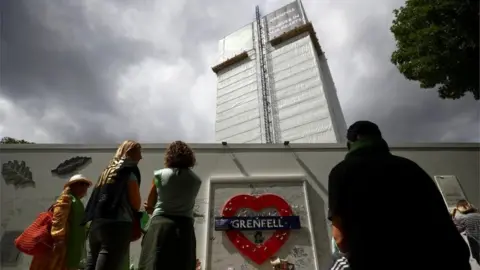Homeowners to get 15 years to sue for 'shoddy' workmanship - minister
Homeowners in England and Wales will get 15 years to legally challenge shoddy building work in light of the cladding crisis, a minister has said.
This would increase the current six-year period in which legal action can be brought against developers.
Housing Secretary Robert Jenrick said the change would "put new cards in the hands of the leaseholders".
However, speaking to the BBC one leaseholder described the announcement as "smoke and mirrors".
And Labour said it would bring "little relief" as the barriers to mount legal action were "too high and costly".
It comes amid concerns that homeowners are bearing the cost of fire safety works following the Grenfell tragedy.
After the 2017 fire in which 72 people lost their lives, thousands of other blocks of flats were found to be covered in similar dangerous cladding.
This triggered a programme of works to remove the material from buildings, as well as other fire safety improvements, leaving many residents with huge bills.
Speaking to the BBC's Andrew Marr programme, Mr Jenrick said "it is not right that either the leaseholder or the taxpayer" should pay for fire safety changes.
"I'm announcing today we are going to change the law retrospectively to give every homeowner 15 years in which to take action against the people who built their building if there is shoddy workmanship.
"This is a huge step forward - the law as we found it was that you only had six years to take action against the person who built your home.
"That often gives you less protection than if you had bought a toaster or a fridge."
Asked about buildings more than 15 years old, Mr Jenrick said "most of the cladded buildings were built in the period from 2000-17".
He said "not all, but the lions' share that are facing this particular issue will now be helped by this unusual change in the law".
The change will be introduced as part of the Building Safety Bill which is set to be published on Monday.
The government says the change would be applied retrospectively for new builds.
"This could mean that residents of a building completed in 2010 that is unfit to live in, such as from unsafe cladding installed on the building when constructed, would be able to bring proceedings against the developer until 2025," the government says.
'A hellish four years'
But Will Martin - a leaseholder of a property in Sheffield - told the BBC Mr Jenrick's announcement left many questions.
"My building is over 15 years old and my developer is insolvent - what is he going to do where the developer has become insolvent," he asked.
"What is he going to do where the developer put legal materials on the side of the building but where the materials are now illegal.
"I don't know when my building is going to be made safe, I don't know when I will be able to sell, I don't know when I will be able to move on with my life - it's been a hellish four years," he said.
He also expressed concern that many properties would fall out of the time limit, by the time the new rule change is implemented.
Giles Grover a leaseholder from Manchester said he was concerned about the practicalities of residents taking on a developer in court. "They will have a better legal team and will be able to kick it in to the long grass," he said.
While Kean Silvester from Brighton told the BBC he could consider making use of the extended time limit but was concerned the companies would have "an army of lawyers" and that legal action could be "expensive and risky".
Labour's shadow housing secretary Lucy Powell said the government's announcement would "bring little relief to homeowners trapped in unsellable, unmortgagable homes, as those already in the scope of the deadline have found barriers to mount legal action too high and costly, and outcomes ineffective".
Instead she said leaseholders should be legally protected from costs and a building works agency should be set up to "pursue developers themselves, to ensure the polluter pays".
 Reuters
ReutersMr Jenrick said he had "huge sympathy" for people facing high costs adding that, except for a few cases, all Grenfell-style cladding would be removed from buildings by the end of the year.
In February, the government set aside £3.5bn to replace unsafe cladding for residential buildings 18m (six storeys) or higher in England.
This was on top of £1.6bn announced in 2020 for the removal of unsafe cladding.
For buildings under 18m, residents can access a loan to help pay for removal, towards which they pay a maximum of £50 a month.
However, campaigners have argued that many leaseholders are also facing bills to pay for other safety measures such as fire breaks, safer doors and sprinkler systems.

Are you affected by issues covered in this story? Share your experiences by emailing [email protected].
Please include a contact number if you are willing to speak to a BBC journalist. You can also get in touch in the following ways:
- WhatsApp: +44 7756 165803
- Tweet: @BBC_HaveYourSay
- Upload pictures or video
- Please read our terms & conditions and privacy policy
If you are reading this page and can't see the form you will need to visit the mobile version of the BBC website to submit your question or comment or you can email us at [email protected]. Please include your name, age and location with any submission.
